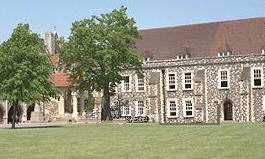
A Caning at King's School
All the great Public Schools for Boys in the United Kingdom used Corporal Punishment for the maintenance of good order and discipline from the time of their foundation until caning became unfashionable in the 1990s. It was used also, but to a much more limited extent, in some similar schools for girls. Though it was still practised in boys' schools until quite recently, the use of all forms of corporal punishment has now been made illegal in all schools, both state and private, to conform to European law.
Discipline in the Public Schools was not a matter for the Teaching Staff, who concerned themselves solely with welfare and teaching, but was left to the senior boys appointed as 'Prefects' known in some schools as 'Monitors'. They were normally appointed by the Headmaster in conjunction with the boy's Housemaster and chosen from boys who had excelled either in the classroom or on the sports' fields or who had otherwise shown qualities of leadership. There is no doubt that, on rare occasions, appointments were made on grounds of nepotism or favouritism, perhaps as a result of a cosy, but wholly improper, relationship between master and pupil.
Though these various punishments were available, a caning was often the first choice for the prefect as it required less effort on his part than supervising a PD or checking lines and was certainly more fun. Indeed boys often preferred a caning to a double PD and those with two PDs were often seen to offend again to 'upgrade' from 3 PDs to a caning! Though the caning ritual was broadly similar in the various Public Schools each had its own, particular and rigorously observed, protocol to deal with a delinquent boy. The account below is, in detail, the procedure at The King's School in Canterbury founded by King Henry the Eighth, situated in the beautiful precincts of Canterbury Cathedral, and arguably the oldest school of it's kind with, at that time, about 300 boarding pupils.
The severity of a caning at King's related not to the offence which had been committed
but rather to the age or seniority of the offender. Thus a boy offending in his first
term would receive only four strokes whilst during his subsequent first two years,
six would be the rule. For third year, and more senior, boys the punishment was eight
strokes regardless of the offence. Thus a relatively minor offence such as walking
round the Green Court, part of Canterbury Cathedral Precincts, in an anti-
A boy caught committing an offence would be told by the monitor to come and see him at some later appointed time, perhaps 'after lunch'. The interview would take place in a study allocated for the general communal use of the monitors. The boy would be asked for his excuses and these, as often as not, would be summarily dismissed. Unless some lesser punishment was allocated, the boy would be told simply "I will see you later". This delay, probably overnight, was necessary so that the preliminaries required prior to a caning could be accomplished.
First, permission for the caning would have to be sought by the prefect from the boy's housemaster. Some housemasters would enquire into the circumstances, some merely grant automatic permission but I can remember no case where permission was withheld. Then the other monitors had to be consulted and a time arranged. The boy or boys scheduled for caning would be told, probably by a public announcement, to attend the monitors' study which, at King's, was formally known as the 'Old Grange'; particularly when being used for canings. Thus the canings themselves became known as 'Old Granges'. The Old Grange itself was, in the 1930s, situated in an historic block of houses facing onto the Green Court.
At the appointed time the boys due for caning would form up in the corridor outside the Old Grange door and wait to be called in. Usually promptly, the door would open and the first in the queue invited to enter. Along two walls of the Old Grange would be assembled the entire complement of, up to a dozen Monitors, dressed in their purple gowns and ready to watch the canings. The monitor who had caught the culprit and who was to administer the strokes would be standing in the middle of the room, cane in hand, and at the far end of the room would be two chairs, back to back. Artist's Impression of The Old Grange in Action
"Jones", or whoever, the monitor would announce in the prescribed words. "I propose to beat you for having only two buttons of your jacket fastened. Have you anything to say ?" As whatever Jones might answer at this point would be dismissed, I always just said "No", though many boys did have a last, always fruitless, attempt at an excuse.
"Very well then, please kneel on the chair, lean over the back and grasp the bottom bars of the other chair". Once Jones was in position, bottom high in the air, the request would be made, "Junior Monitor, will you adjust his jacket please." The junior monitor would then step forward and fold back the boy's jacket well clear of his buttocks and the caning would commence.
For each stroke the caning monitor would take a short run supposedly to give added momentum to his swing, though in my opinion a harder delivery could be obtained without the run. Strokes were always given 'as hard as possible' the severity of a caning depending on only the number of strokes. The sound of running footsteps was, however, quite intimidating for the culprit! Then a pause of a little under ten seconds before the next stroke. After the last stroke, the monitor would dismiss the boy with the words, "You may go now", the boy would rise, adjust his jacket, move towards the monitor and thank him with a simple "Thank you". Elaborations on this were rebuked and a rare failure, or refusal, to say the necessary words merited an immediate additional two strokes. I remember on one occasion adding the words "an excellent job!" to my 'thank you' meaning that it had hurt more than usual. I received two extra for cheek!
As 'Jones' left the room, the next boy would enter to take his place while he chatted to the others in the queue and gave his bottom a good rub!. Almost all boys took their beatings well and tried to remain silent, most were unable to avoid a moan, grunt or "arrgh!" after the third or fourth and subsequent strokes; a clear source of satisfaction to the caner! After the canings, the Captain of the School usually posted a notice on the main School Notice Board giving details of the caning which had just taken place. This would remain in position for seven days. (Example of a Notice of Caning)
Considerable rivalry existed in the degree and evenness of the bruising displayed
after a beating and the resulting deep reddish-
Though, these days, considered by some to be a cruel punishment, I never found it so and must admit that the several canings that I received in the Old Grange during the 1940s certainly improved my character and turned me into a better citizen and nicer person than I would otherwise have been!
A.H.L.
